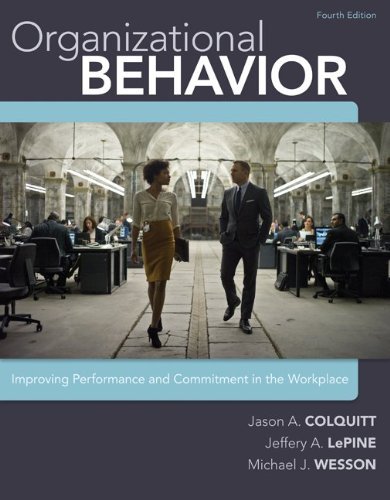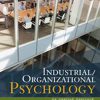Organizational Behavior Improving Performance and Commitment in the Workplace Colquitt 4th Edition Test Bank
$35.00 Original price was: $35.00.$26.50Current price is: $26.50.
Organizational Behavior Improving Performance and Commitment in the Workplace Colquitt 4th Edition Test Bank
Organizational Behavior Improving Performance and Commitment in the Workplace Colquitt 4th Edition Test Bank

Product details:
- ISBN-10 : 007802935X
- ISBN-13 : 978-0078029356
- Author:
Now in its third edition, Colquitt-LePine-Wesson continues to offer a novel and innovative approach to teaching organizational behavior. The focus, tone, and organization of the book shows students that:
OB really matters – The book opens with two chapters barely covered in other texts: job performance and organizational commitment. Those topics are critical to managers and students alike, and represent two of the most critical outcomes in OB. Each successive chapter then links that chapter’s topic back to those outcomes, illustrating why OB matters in today’s organizations.
Description:
Chapter 3
1. Organizational commitment is the desire on the part of an employee to remain a member of the
organization.
True False
2. The three types of organizational commitment are continuance, normative, and affective.
True False
3. Affective commitment is defined as a desire to remain a member of an organization due to an emotional
attachment to, and involvement with, that organization.
True False
4. Continuance commitment is defined as a desire to remain a member of an organization due to a feeling of
obligation.
True False
5. Employees who feel a sense of continuance commitment identify with the organization, accept that
organization’s goals and values, and are more willing to exert extra effort on behalf of the organization.
True
False
6. The erosion model suggests that employees who have direct linkages with “leavers” will themselves
become more likely to leave.
True False
7. The social influence model of withdrawal behavior suggests that employees with fewer bonds will be
most likely to quit the organization.
True False
8. A lack of employment alternatives is one of the factors that increase continuance commitment.
True False
9. Continuance commitment tends to create more of a passive form of loyalty.
True False
10. Embeddedness summarizes a person’s links to the organization and the community, his/her sense of fit
with that organization and community, and what he/she would have to sacrifice for a job change.
True False
11. Jack grew up in Peoria. Both his family and his wife’s family live there. This family background would
create a high level of affective commitment.
True False
12. Continuance commitment focuses on personal and family issues more than affective and normative
commitment.
True False
13. Continuance commitment exists when there’s a profit associated with staying and a cost associated with
leaving.
True False
14. Affective commitment exists when there is a sense that staying is the “right” or “moral” thing to do.
True False15. Exit is defined as a passive, destructive response to a negative work event in which interest and effort on
the job declines.
True False
16. Voice is defined as a passive, constructive response to a negative work event that maintains public
support for the situation while the individual privately hopes for improvement.
True False
17. Loyalty is defined as an active, constructive response to a negative work event in which individuals
attempt to improve the situation.
True False
18. Organizational commitment should increase the likelihood that an individual will respond to a negative
work event with voice or loyalty.
True False
19. Employees falling under the category of “lone wolves” tend to respond to negative events with voice
because they have the desire to improve the status quo and the credibility needed to inspire change.
True False
20. Employees categorized as citizens demonstrate the highest levels of organizational commitment and
behave in an active, constructive manner.
True False
21. Employees in the category of apathetics are demonstrate passive, destructive behavior. They exert the
minimum level of effort required to keep their jobs.
True False
22. Employees falling under the category of “stars” possess low levels of organizational commitment but
high levels of task performance and are motivated to achieve work goals for themselves, not necessarily
for their company.
True False
23. Employees falling under the category of “lone wolves” possess low levels of both organizational
commitment and task performance and merely exert the minimum level of effort needed to keep their
jobs.
True False
24. Examples of psychological withdrawal include missing meetings and tardiness.
True False
25. When employees engage in moonlighting, they use work time and resources to complete something other
than their job duties, such as assignments for another job.
True False
26. Tardiness reflects the tendency to arrive at work late or leave work early.
True False
27. The most serious form of physical withdrawal is absenteeism.
True False
28. The independent forms model of withdrawal argues that the various withdrawal behaviors are
uncorrelated with one another, occur for different reasons, and fulfill different needs on the part of
employees.
True False
29. The compensatory forms model of withdrawal argues that the various withdrawal behaviors are positively
correlated.
True False30. The progression model of withdrawal argues that the various withdrawal behaviors negatively correlate
with one another—that doing one means you’re less likely to do another. The idea is that any form of
withdrawal can compensate for, or neutralize, a sense of dissatisfaction, which makes the other forms
unnecessary.
True False
31. Survivor syndrome refers to the anger, depression, fear, distrust, and guilt of the employees who remain
after an organization downsizes.
True False
32. The retirement of the Baby Boomers will have no effect on the country’s economic output.
True False
33. Psychological contracts reflect employees’ beliefs about what they owe the organization and what the
organization owes them.
True False
34. Transactional contracts are based on a narrow set of specific monetary obligations.
True False
35. Which of the following terms refers to the desire on the part of an employee to remain a member of the
organization?
A. Organizational efficacy
B. Organizational control
C. Organizational efficiency
D. Organizational commitment
E. Organizational effectiveness
36. The set of actions that employees perform to avoid the work situation that may eventually culminate in
the employee quitting the organization are referred to as _____ behavior.
A. productivity
B. commitment
C. performance
D. withdrawal
E. citizenship
37. Which of the following is one of the three types of organizational commitment?
A. Reactive commitment
B. Associative commitment
C. Normative commitment
D. Proactive commitment
E. Distributive commitment
38. The desire to remain a member of an organization due to emotional attachment to, and involvement with,
that organization is called “_____ commitment.”
A. continuance
B. affective
C. evaluative
D. normative
E. associative
39. Jacklyn loves her job, admires her boss, believes in the goals and vision of the company. She can’t
imagine looking for or finding a better job. Jacklyn most likely would demonstrate ______.
A. a high level of organizational commitment
B. a normative level of organizational commitment
C. high performance
D. low performance
E. daydreaming and socializing40. “_____ commitment” is defined as a desire to remain a member of an organization because of an
awareness of the costs associated with leaving it.
A. Continuance
B. Affective
C. Associative
D. Normative
E. Situational
41. A desire to remain a member of an organization due to a feeling of obligation is called _____
commitment.
A. continuance
B. affective
C. associative
D. normative
E. evaluative
42. Mauve has been working as the creative head at Juno Designs for the past 10 years. Her growth at Juno
has made her one of the finest designers in the field. Of late Mauve has been receiving several offers and
inquiries from head hunters from other companies. Mauve feels that she should stay with Juno Designs
because her retirement benefit increases during her later years of service as opposed to her initial years of
service. This is an example of _____ commitment.
A. continuance
B. affective
C. ethical
D. normative
E. associative
43. Which of the following terms refers to the various people, places, and things that can inspire a desire to
remain a member of an organization?
A. Focus of influence
B. Focus of commitment
C. Focus of attention
D. Focus of performance
E. Focus of dominance
44. The term “focus of commitment” refers to all of the following EXCEPT:
A. supervisors.
B. company’s top management.
C. salary.
D. specific coworkers.
E. industry regulations.
45. Employees who feel a sense of _____ commitment tend to engage in more interpersonal and
organizational citizenship behaviors, such as helping, sportsmanship, and boosterism.
A. normative
B. evaluative
C. affective
D. proactive
E. continuance
46. The _____ model suggests that employees with fewer bonds will be most likely to quit the organization.
A. social influence
B. social impact
C. erosion
D. decay
E. continuity
People also search:
how can hr improve organizational performance
impact of organizational performance
impact of personality on performance in organizational behaviour
what is behavioral performance management
how organizational behavior affects organizational performance
how individual behaviour affects organizational effectiveness
what are the characteristics of effective performance management
Related products
Test Bank
Test Bank for Essentials of Business Law and the Legal Environment, 11th Edition: Richard A. Mann











